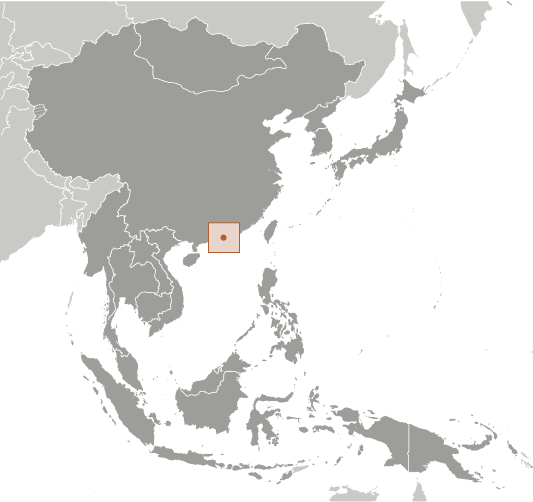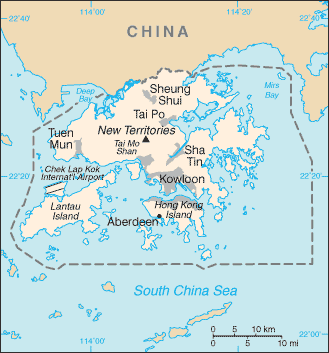|
Economy - overview:
|

|
|
Hong Kong has a free market economy, highly dependent on international trade and finance - the value of goods and services trade, including the sizable share of re-exports, is about four times GDP. Hong Kong levies excise duties on only four commodities, namely: hard alcohol, tobacco, hydrocarbon oil, and methyl alcohol. There are no quotas or dumping laws. Hong Kong's open economy left it exposed to the global economic slowdown that began in 2008. Although increasing integration with China, through trade, tourism, and financial links, helped it to make an initial recovery more quickly than many observers anticipated, it again faces a possible slowdown as exports to the Euro zone and US slump. The Hong Kong government is promoting the Special Administrative Region (SAR) as the site for Chinese renminbi (RMB) internationalization. Hong Kong residents are allowed to establish RMB-denominated savings accounts; RMB-denominated corporate and Chinese government bonds have been issued in Hong Kong; and RMB trade settlement is allowed. The territory far exceeded the RMB conversion quota set by Beijing for trade settlements in 2010 due to the growth of earnings from exports to the mainland. RMB deposits grew to roughly 9.1% of total system deposits in Hong Kong by the end of 2012, an increase of 59% from the previous year. The government is pursuing efforts to introduce additional use of RMB in Hong Kong financial markets and is seeking to expand the RMB quota. The mainland has long been Hong Kong's largest trading partner, accounting for about half of Hong Kong's exports by value. Hong Kong's natural resources are limited, and food and raw materials must be imported. As a result of China's easing of travel restrictions, the number of mainland tourists to the territory has surged from 4.5 million in 2001 to 34.9 million in 2012, outnumbering visitors from all other countries combined. Hong Kong has also established itself as the premier stock market for Chinese firms seeking to list abroad. In 2012 mainland Chinese companies constituted about 46.6% of the firms listed on the Hong Kong Stock Exchange and accounted for about 57.4% of the Exchange's market capitalization. During the past decade, as Hong Kong's manufacturing industry moved to the mainland, its service industry has grown rapidly. Growth slowed to 5% in 2011, and less than 2% in 2012. Credit expansion and tight housing supply conditions caused Hong Kong property prices to rise rapidly and inflation to rise 4.1% in 2012. Lower and middle income segments of the population are increasingly unable to afford adequate housing. Hong Kong continues to link its currency closely to the US dollar, maintaining an arrangement established in 1983.
|
|
|
GDP (purchasing power parity):
|

|
|
$363.7 billion (2012 est.)
country comparison to the world: 36
$357.2 billion (2011 est.)
$340.1 billion (2010 est.)
note:
data are in 2012 US dollars
|
|
|
GDP (official exchange rate):
|

|
|
$261.6 billion (2012 est.)
|
|
|
GDP - real growth rate:
|

|
|
1.8% (2012 est.)
country comparison to the world: 144
5% (2011 est.)
7.1% (2010 est.)
|
|
|
GDP - per capita (PPP):
|

|
|
$50,700 (2012 est.)
country comparison to the world: 13
$50,200 (2011 est.)
$48,200 (2010 est.)
note:
data are in 2012 US dollars
|
|
|
GDP - composition by sector:
|

|
|
agriculture: 0%
industry:
7%
services:
93% (2012 est.)
|
|
|
Labor force:
|

|
|
3.826 million (2012 est.)
country comparison to the world: 94
|
|
|
Labor force - by occupation:
|

|
|
manufacturing: 4%
construction:
2.7%
wholesale and retail trade, restaurants, and hotels:
40.9%
financing, insurance, and real estate:
12.5%
transport and communications:
9.9%
community and social services:
16.9%
note:
above data exclude public sector (2012 est.)
|
|
|
Unemployment rate:
|

|
|
3.3% (2012 est.)
country comparison to the world: 28
3.4% (2011 est.)
|
|
|
Population below poverty line:
|

|
|
NA%
|
|
|
Household income or consumption by percentage share:
|

|
|
lowest 10%: NA%
highest 10%:
NA%
|
|
|
Distribution of family income - Gini index:
|

|
|
53.7 (2011)
country comparison to the world: 11
53.3 (2007)
|
|
|
Investment (gross fixed):
|

|
|
26.3% of GDP (2012 est.)
country comparison to the world: 42
|
|
|
Budget:
|

|
|
revenues: $57.12 billion
expenditures:
$48.79 billion (2012 est.)
|
|
|
Taxes and other revenues:
|

|
|
21.8% of GDP (2012 est.)
country comparison to the world: 144
|
|
|
Budget surplus (+) or deficit (-):
|

|
|
3.2% of GDP (2012 est.)
country comparison to the world: 17
|
|
|
Public debt:
|

|
|
30% of GDP (2012 est.)
country comparison to the world: 114
39.8% of GDP (2011 est.)
|
|
|
Inflation rate (consumer prices):
|

|
|
4.1% (2012 est.)
country comparison to the world: 118
5.3% (2011 est.)
|
|
|
Central bank discount rate:
|

|
|
0.5% (31 December 2012)
country comparison to the world: 138
0.5% (31 December 2011)
|
|
|
Commercial bank prime lending rate:
|

|
|
5% (31 December 2012 est.)
country comparison to the world: 158
5% (31 December 2011 est.)
|
|
|
Stock of narrow money:
|

|
|
$176.6 billion (31 December 2012 est.)
country comparison to the world: 21
$144.5 billion (31 December 2011 est.)
|
|
|
Stock of broad money:
|

|
|
$1.148 trillion (31 December 2012 est.)
country comparison to the world: 16
$1.033 trillion (31 December 2011 est.)
|
|
|
Stock of domestic credit:
|

|
|
$714 billion (31 December 2012 est.)
country comparison to the world: 21
$651.4 billion (31 December 2011 est.)
|
|
|
Market value of publicly traded shares:
|

|
|
$2.81 trillion (31 December 2012)
country comparison to the world: 6
$2.24 trillion (31 December 2011)
$2.711 trillion (31 December 2010 est.)
|
|
|
Agriculture - products:
|

|
|
fresh vegetables; poultry, pork; fish
|
|
|
Industries:
|

|
|
textiles, clothing, tourism, banking, shipping, electronics, plastics, toys, watches, clocks
|
|
|
Industrial production growth rate:
|

|
|
-0.1% (2012 est.)
country comparison to the world: 147
|
|
|
Current account balance:
|

|
|
$6.4 billion (2012 est.)
country comparison to the world: 28
$14.1 billion (2011 est.)
|
|
|
Exports:
|

|
|
$439 billion (2012 est.)
country comparison to the world: 13
$438 billion (2011 est.)
|
|
|
Exports - commodities:
|

|
|
electrical machinery and appliances, textiles, apparel, footwear, watches and clocks, toys, plastics, precious stones, printed material
|
|
|
Exports - partners:
|

|
|
China 54.1%, US 9.9%, Japan 4% (2012 est.)
|
|
|
Imports:
|

|
|
$499.4 billion (2012 est.)
country comparison to the world: 10
$494.1 billion (2011 est.)
|
|
|
Imports - commodities:
|

|
|
raw materials and semi-manufactures, consumer goods, capital goods, foodstuffs, fuel (most is reexported)
|
|
|
Imports - partners:
|

|
|
China 46.9%, Japan 8.4%, Taiwan 7.5%, South Korea 5%, US 4.7% (2012 est.)
|
|
|
Reserves of foreign exchange and gold:
|

|
|
$317.3 billion (31 December 2012 est.)
country comparison to the world: 10
$285.4 billion (31 December 2011 est.)
|
|
|
Debt - external:
|

|
|
$995.4 billion (30 September 2012 est.)
country comparison to the world: 17
$903.2 billion (30 June 2011 est.)
|
|
|
Stock of direct foreign investment - at home:
|

|
|
$1.2 trillion (31 December 2012 est.)
country comparison to the world: 4
$1.138 trillion (31 December 2011 est.)
|
|
|
Stock of direct foreign investment - abroad:
|

|
|
$1.112 trillion (31 December 2012 est.)
country comparison to the world: 5
$1.046 trillion (31 December 2011 est.)
|
|
|
Exchange rates:
|

|
|
Hong Kong dollars (HKD) per US dollar -
7.76 (2012 est.)
7.784 (2011 est.)
7.77 (2010 est.)
7.75 (2009)
7.751 (2008)
|
|
|
Fiscal year:
|

|
|
1 April - 31 March
|
|
|
|





 )
)



